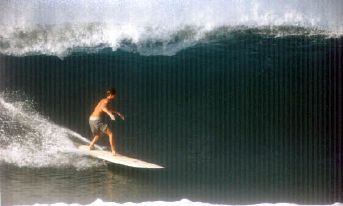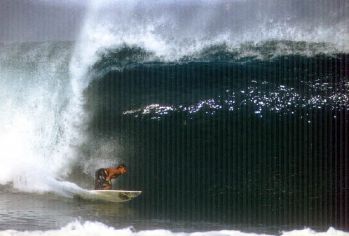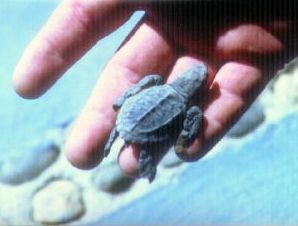

In many cases it means a day off, at the very least it's cause for a special lunch or dinner, or a full-blown, boogie-til-dawn party.
As well as Mother's Day (May 10) and one for Father's (third Sunday in June), there is a Children's Day (April 30), a Student's Day (May 24). And this month, there's Senior's Day, Aug. 29.
 But that's just the beginning: Aug. 4 is Day of the Priest; Aug. 17 is Veterinarian's Day; Aug.
22 is Day of the Fireman. But the big day in Puerto Escondido is Aug. 12, Taxi Driver's Day.
But that's just the beginning: Aug. 4 is Day of the Priest; Aug. 17 is Veterinarian's Day; Aug.
22 is Day of the Fireman. But the big day in Puerto Escondido is Aug. 12, Taxi Driver's Day.
The cabs are adorned with flowers, ribbons and streamers. At 8 a.m. the entire Puerto Escondido taxi fleet assembles near the church for a special mass and blessing of the cabs. Then the vehicles parade through the streets of town.
There's a special lunch for the drivers and private parties later when the shifts change. Don't be surprised to find fewer vehicles on the streets today. If you can find one, give your driver a tip and tell him "felicidades!"
They hold up to 5 passengers, two up front with the driver and three in the back. (Tip #1: always choose the back seat if you have the choice.) It cost 2½ pesos to ride. Hop off as they get close to your destination.
A regular cab will charge you 12 pesos for a ride from, say, the commercial center of town to the Adoquín or one of the nearer colonias. But for longer trips, from Zicatela to Bacocho, for example, the rate might be 15.
At night, expect to pay more, starting at 15 pesos for short trips and up to 25 for longer ones.
For out of town journeys, negotiate a price with the driver, or call the radio dispatch office at 562-0990 and ask them the going rate for the trip.
Sun 5
Election Day
Oaxacans go to the polls today to choose their state deputies. This means that the "Dry Law" is
in effect. Alcohol cannot be sold or served in commercial establishments from midnight on Saturday
until midnight Sunday,
Wed 8
Birthday of Emiliano Zapata
The most appealing figure of the Mexican Revolution was born on this day in 1879 in San Miguel
Anenecuilco, Morelos. Under his slogan "Land and Freedom!", he became the apostle of agrarian
reform and was perhaps the purist of the heroes of the revolution.
Lured into a treacherous ambush by Col. Jesús M. Guajardo in Chinameca, Morelos on April 10, 1919, he died with ten of his followers. Time has not diminished the appeal of Zapata or the nobility of his principles.
Thu 9
Birthday of Vicente Guerrero
The hero of Mexico's Independence struggle was born on this day in Tixtla, Guerrero in 1782. As the
early leaders of the 1810 insurgency were captured and executed, it fell to Guerrero to keep the
uprising against Spain alive.
Guerrero was president of the young volatile republic in 1829. Forced again to take up arms against the government, he was betrayed by a Genoan ship's captain who turned him over to his enemies on what is now called La Entrega beach in Huatulco. (La entrega means the handing over or the delivery). Guerrero was executed at Culiapan, Oaxaca on Feb. 14, 1831.
Sun 12
Taxi Driver's Day
Puerto's cabs are bedecked with flowers and streamers as the drivers celebrate their special
day. See story.
Mon 13 - Wed 15
Feast of the Ascension Of the Holy Virgin
This patron's festival will be celebrated in Santa Maria Tonameca (near Pochutla) with parades,
fireworks, dances and rodeos, as well as the religious observations. The lighting of the
castillo (castle or tower) of spectacular fireworks always takes place on the verbena
or saint's day eve (Aug. 14).
Santa Maria Tonameca is off the coast highway between San Antonio (where you take the road to Mazunte) and San Pedro Pochutla.
Other communities will celebrate with fiestas including Santa María Colotepec and San Pedro Mixtepec.
Sat 18
New Moon
in Leo at 9:56 p..m.
 Wed 22 - Sun Sep. 2
Wed 22 - Sun Sep. 2
MexPipe Open 01 Surf Tournament
This is the third year for this tournament that takes advantage of what are normally great surf
conditions in August. This year the format is different; it's a winner takes all contest for the
$10,000 pesos prize. It is designed so that every contestant surfs at least 3 qualifying heats,
adding points to advance to the following rounds.
There will also be Air Time, Single Fin and Switch Stand events, with winners receiving goods and services donated by the sponsors.
Entry fee is $400 pesos. More information and sign-up at the MexPipe surf shop.
Tue 28 - Thu 30
Feast of Santa Rosa de Lima
Like México's Virgin of Guadalupe, this religious figure came out of the New World and is venerated
throughout Latin America. There's a town named for her near just past Rio Grande on the coast
highway towards Jamiltepec and Pinotepa Nacional.
The Chatino community of Santa Rosa near San Juan Lachao Pueblo Nuevo, on the Oaxaca road via Sola de Vega, will also host fiesta activities during these days.
Radio, Radio
Sunday 8 p.m. to 10 p.m.
Chiles y Chocolates, a bilingual radio program hosted by "Lucy Sonido", actually Canadian
musicologist Helena Szutska, an eclectic mix of music from around the world.
Wed. at 9 p.m.
La Luciernaga (The Firefly)
Lucy's midweek, commercial-free hour of free-flowing music. Radio Esmeralda, 94.1
FM.
 White sand, sweeping vistas and swaying palms, negative ions. Beaches are Puerto
White sand, sweeping vistas and swaying palms, negative ions. Beaches are Puerto
Playa Principal
This is where many of the fishing boats put out and where you'll find a lancha to taxi
you to one of the outer beaches. It abuts the pedestrian mall (known as the Adoquín) that is the
heart of the town's tourist section. Here, as well as on most of the other town beaches, small
palapa restaurants offer food, beer and soft drinks.
It is floodlit to allow visitors safe use of the beach at night.
Playa Marinero
It adjoins Playa Principal to the southeast. It is a little more laid back and cleaner, but it,
too, contains ample services for beach enthusiasts. You rent boogie boards here and surf if you are
a beginner.
 Playa Zicatela
Playa Zicatela
Around the rocky point known as las Rocas del Morro lies one of the top-rated surfing beaches in
the world. It is NOT a swimming beach and only experienced surfers should attempt to ride its
waves. More suitable for bathing and snorkeling are the beaches to the other side of town. It's a
good walking beach: a good workout is a hike to the point (la punta) and back. And of
course to watch surfing wizardry.
Puerto Piedra
A tiny quiet rocky cove with a nice little beach at low tides, accessible from the scenic
walkway that begins in front of the Harbor Master's. You can also get there from the stairway at
the side of the disco Tequila Sunrise. It sits right in front of the beach-front nitespot. Good
diving and snorkeling.
Puerto Angelito, Playa Manzanillo
They share a sheltered cove, the two beaches divided by a rocky outcrop. Angelito is accessible
by a dirt road, so it tends to be the busier of the two. Both can be reached by launch taxi or are
a short walk from town. (Look for Calle Puerto Angelito, or take the long stairway down from the
end of Calle 5 Sur.)
Playa Carrizalillo
This is the next cove along the shore and, with its gentle waters and fine golden sand, it's
perhaps the prettiest of them all. But access is a little difficult down a steep path from
Riconada, through the new Fracc. Carrizalillo housing development
Playa Bacocho
Along the broad stretch of Bacocho Beach the sea regains its mighty force. Bacocho is home to
two of Puerto's best hotels. The Hotel Days Inn VillaSol and the Posada Real both have beach clubs
offering snacks, full meals and refreshments and a variety of entertainments. Great sunsets from
here.
Just 15 minutes from town is Manialtepec Lagoon, a river-fed, mangrove-surrounded lake that is typical of the topography along the Oaxacan coast. These mangrove wetlands are one of the richest sources of biodiversity in the world.
Even closer is Palmazola at Barra de Navidad, which we profiled in last month's edition.
An hour away is Chacahua Lagoon National Park, an even more extensive stretch of wetlands, where, like Manialtepec, launch tours explore the wealth of bird and other wildlife and how all these elements sustain a unified ecosystem.
In the foothills of the southern Sierra Madre around Santos Reyes Nopala and above Pochutla you can visit an organic coffee plantation and observe the abundant wildlife that thrives in the tropical forest.
But here are just some of the other stops you can enjoy within that 70 Km stretch from Puerto Escondido to El Mariposerio, along the Eco-Trail:
Ventanilla The families who live in this small community on the road from Mazunte to the Coast Highway decided that eco-tourism could provide them a better livelihood. So they organized, cleaned up and are conserving their small lagoon and its abundant wildlife.
Tours are given in paddled boats without motors, so the animals are not frightened away by the noise. You'll get as close as you want to be to huge crocodiles and the nesting birds barely stir as you glide just feet away from them.
You will also visit the nursery, part of their reforestation project and a crocodile and iguana enclosure
The Iguana Hatchery Iguanas are such a familiar feature of the Mexican landscape that is surprising to learned that these creatures are endangered. But Elpidio Marcelino is trying to help. At his Iguana Hatchery (Criadero de Iguanas) perched below the bridge over the Cotzoaltepec River, you can see hundreds of iguanas in all their stages of development.
There are two distinct varieties, the more common black iguana which is found in dry areas and the prehistoric looking green iguana which favors river and lagoon banks.
Agua Blanca 21 Km from Puerto Escondido you will see the sign for this undeveloped beach notable for its tide pools. Check the tide table for the times for low tides and study the marine life captured in the pools. There are no services and little shade on this beach.
The rich biodiversity of the state of Oaxaca is one of its greatest resources and the growth in eco-tourism offers the best hope for preserving these treasures for future generations.
Mazunte Once the local center for the harvesting of turtles, today it's home to The Mexican Turtle Center, a government-run museum, marine turtle aquarium and research and breeding facility where you can learn everything about these ancient creatures.
You'll also find the Natural Cosmetics Cooperative, formed to provide a livelihood for local families after turtles were placed under federal protection. (Read here for more on Turtles)
 With the increase in rainfall that we can expect during the month of August more sea turtles can be
seen along Oaxaca's beaches.
With the increase in rainfall that we can expect during the month of August more sea turtles can be
seen along Oaxaca's beaches.
It's a ritual older than mans history on the planet. Thousands of female marine turtles will laboriously drag themselves from the sea onto the beaches of Oaxaca to lay their eggs.
They arrive during the late evening and through the night. The female will dig a hole in the sand and deposit an average of 100 eggs, then meticulously cover the nest before returning to the sea. The process takes about one hour.
The species most commonly seen along the coast of Oaxaca is the Olive Ridley, although the Leatherback and the Black turtle also inhabit these waters.
The Olive Ridley, which has a life span of up to 35 years, begins to procreate at eight to 10 years of age. The females may, during the course of the season, nest up to three times. The incubation period is 45 days.
During the course of the season an enormous number of eggs are produced, but, says Javier Vasconcelos Pérez, head of the Mexican Turtle Center, only 3 to 4 percent of the hatchlings will reach maturity.
And, although it is against the law, nests on unprotected beaches are routinely raided for the eggs. Dogs also destroy nests; pollution and environmental factors further reduce the turtle population.
These magnificent creatures, which scientists estimate have been on Earth for 150 million years, were being harvested to near extinction. In 1990 the Mexican government afforded marine turtles total protection, making it illegal to kill or even harm these creatures. Shortly thereafter the Mexican Turtle Center was formed, under the aegis of the National Fisheries Institute, to study and protect the species and to raise consciousness about the importance of conservation efforts.
Mazunte, site of the center, near Puerto Angel, was a center for harvesting the animals. Some 50,000 turtles were slaughtered each year as they came on shore to nest, and their weathered white bones and shells were strewn about for the tides and storms to remove.
The center includes an aquarium displaying all varieties of marine turtles found in Mexico. The guided tours will tell you more about the local nesting cycle.
The center is open from 10 a.m. to 4:30 p.m Tuesday through Saturday; Closed on Sundays and Mondays.
If You Come Across a Turtle:
Compared to most resorts, it is also a bargain. While we lack the spiffy sports fishing yachts of some ports, Puerto's fleet of 18 to 23 feet lanchas and the knowledgeable skippers from the Sports Fishing Cooperative are capable of hauling in anything from grouper to marlin.
The going rate is 300 pesos an hour, and the launches can normally accommodate four people on a fishing trip. You'll want to leave at dawn and return by noon. That's when the fish are biting and you'll avoid the hottest part of the day. Take a hat. Prepare your food and drinks the night before because few stores are open at that hour near the beach.
Most hotels can arrange for a knowledgeable and honest skipper or you can stop at the office for the local sports fishing and tour boat cooperative, located on Av. Marina Nacional, near the Adoquín (Tel: 582-1303 or 582-1678).
Sailfish and marlin are caught all year off Puerto's shores, but the warm August waters bring greater numbers, plus dorado (mahi-mahi or dolphin fish), and bonito,
Sailfish are found in warmer blue waters and typically range from 35 to 50 kilos. They are most plentiful from June to September.
The blue marlin and black marlin (Makaira indica/Makaira nigricans) which can weigh up to several hundred kilos are much more elusive; an average of two to five are caught here each month. And, like the sailfish, summer is the best time for fishing them.
Yellowfin tuna (atun aleta amarillo, Thunnus albacares) are most common from November through March, ranging in size from 3 to 100 kilos, but eight to 10 kilos is the norm.
Perhaps one of the most exciting thrills for a fisher is to catch a dolphin fish or mahi mahi (dorado). These electric-blue and emerald-hued fish grow to about 55 kilos, but they can fight, jumping and twisting out of the water and they are capable of amazing bursts of speed.
They like to hide among floating debris, so they, too, are particularly plentiful this time of year when river runoff is at its peak.
Rooster fish (pez gallo, Nematistius pectoralis) is another prized catch for the serious fisherman. An iridescent black and blue, about three-feet in length, distinguished by its "cock's comb", it is found in shallow beach areas, often near a river mouth.
Other fish you might encounter: The bonito (barrilete) is particularly common. Black, about two-feet in length, it's not valued as a food fish, despite its good flavor, because of its red flesh.
The Pacific mackerel (sierra, Scomberomorus) is gray with gold spots, about two-feet in length, and provides delicious firm white meat.
The needlefish (agujón tylosurus crocodilus) is one of our favorite eating fish. Normally found in deep water, it is commonly fished at night when it comes closer to shore attracted by the lights. It has delicate white meat with blue bones.
Red snapper (huachinango, lutjanus peru) is also fished at night. Reddish pink, up to two-feet in length, this local staple is commonly found in deep rocky pools.
Snook (róbalo, Centropomus nigrescens), another excellent food fish, is blackish brown, two to three-feet in length, commonly found in and around the lagoons.
Mullet (lisa) is found in shallow, sandy bays, while the grouper (pargo), a rust-brown fish up to 3-feet in length, likes deep water and reefs, an environment that also attracts the sea bass (cabrilla).
More commercial fishermen are going out for shark (tiburón), most common are hammerheads, grays and threshers.
For those who just want to go along for the ride, a morning on the water offers the possibility for a close encounter with turtles, dolphins or whales.